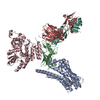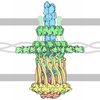+ Open data
Open data
- Basic information
Basic information
| Entry |  | |||||||||
|---|---|---|---|---|---|---|---|---|---|---|
| Title | Structure of nanobody-bound DRD1_LSD complex | |||||||||
 Map data Map data | ||||||||||
 Sample Sample |
| |||||||||
 Keywords Keywords | GPCR / DRD1 / LSD / MEMBRANE PROTEIN | |||||||||
| Function / homology |  Function and homology information Function and homology informationdopamine neurotransmitter receptor activity, coupled via Gs / dopamine neurotransmitter receptor activity / operant conditioning / cerebral cortex GABAergic interneuron migration / Dopamine receptors / dopamine binding / regulation of dopamine uptake involved in synaptic transmission / phospholipase C-activating dopamine receptor signaling pathway / peristalsis / heterotrimeric G-protein binding ...dopamine neurotransmitter receptor activity, coupled via Gs / dopamine neurotransmitter receptor activity / operant conditioning / cerebral cortex GABAergic interneuron migration / Dopamine receptors / dopamine binding / regulation of dopamine uptake involved in synaptic transmission / phospholipase C-activating dopamine receptor signaling pathway / peristalsis / heterotrimeric G-protein binding / modification of postsynaptic structure / G protein-coupled receptor complex / positive regulation of neuron migration / grooming behavior / habituation / regulation of dopamine metabolic process / sensitization / dopamine transport / astrocyte development / dentate gyrus development / striatum development / positive regulation of potassium ion transport / conditioned taste aversion / maternal behavior / arrestin family protein binding / non-motile cilium / long-term synaptic depression / mating behavior / IgG binding / adult walking behavior / ciliary membrane / G protein-coupled dopamine receptor signaling pathway / temperature homeostasis / detection of maltose stimulus / : / maltose transport complex / dopamine metabolic process / transmission of nerve impulse / carbohydrate transport / carbohydrate transmembrane transporter activity / G-protein alpha-subunit binding / maltose binding / maltose transport / maltodextrin transmembrane transport / G protein-coupled receptor signaling pathway, coupled to cyclic nucleotide second messenger / prepulse inhibition / positive regulation of synaptic transmission, glutamatergic / behavioral fear response / neuronal action potential / synapse assembly / ATP-binding cassette (ABC) transporter complex, substrate-binding subunit-containing / adenylate cyclase-activating adrenergic receptor signaling pathway / behavioral response to cocaine / presynaptic modulation of chemical synaptic transmission / ATP-binding cassette (ABC) transporter complex / response to amphetamine / positive regulation of release of sequestered calcium ion into cytosol / cell chemotaxis / synaptic transmission, glutamatergic / G protein-coupled receptor activity / visual learning / GABA-ergic synapse / memory / vasodilation / adenylate cyclase-activating G protein-coupled receptor signaling pathway / long-term synaptic potentiation / protein import into nucleus / cellular response to catecholamine stimulus / adenylate cyclase-activating dopamine receptor signaling pathway / outer membrane-bounded periplasmic space / presynaptic membrane / G alpha (s) signalling events / dendritic spine / postsynaptic membrane / periplasmic space / positive regulation of MAPK cascade / cilium / positive regulation of cell migration / response to xenobiotic stimulus / DNA damage response / endoplasmic reticulum membrane / glutamatergic synapse / extracellular region / nucleus / membrane / plasma membrane Similarity search - Function | |||||||||
| Biological species |  Homo sapiens (human) / Homo sapiens (human) /    Streptococcus sp. 'group G' (bacteria) Streptococcus sp. 'group G' (bacteria) | |||||||||
| Method | single particle reconstruction / cryo EM / Resolution: 3.57 Å | |||||||||
 Authors Authors | Zhuang Y / Xu Y / Fan L / Wang S / Xu HE | |||||||||
| Funding support |  China, 2 items China, 2 items
| |||||||||
 Citation Citation |  Journal: Neuron / Year: 2024 Journal: Neuron / Year: 2024Title: Structural basis of psychedelic LSD recognition at dopamine D receptor. Authors: Luyu Fan / Youwen Zhuang / Hongyu Wu / Huiqiong Li / Youwei Xu / Yue Wang / Licong He / Shishan Wang / Zhangcheng Chen / Jianjun Cheng / H Eric Xu / Sheng Wang /  Abstract: Understanding the kinetics of LSD in receptors and subsequent induced signaling is crucial for comprehending both the psychoactive and therapeutic effects of LSD. Despite extensive research on LSD's ...Understanding the kinetics of LSD in receptors and subsequent induced signaling is crucial for comprehending both the psychoactive and therapeutic effects of LSD. Despite extensive research on LSD's interactions with serotonin 2A and 2B receptors, its behavior on other targets, including dopamine receptors, has remained elusive. Here, we present cryo-EM structures of LSD/PF6142-bound dopamine D receptor (DRD1)-legobody complexes, accompanied by a β-arrestin-mimicking nanobody, NBA3, shedding light on the determinants of G protein coupling versus β-arrestin coupling. Structural analysis unveils a distinctive binding mode of LSD in DRD1, particularly with the ergoline moiety oriented toward TM4. Kinetic investigations uncover an exceptionally rapid dissociation rate of LSD in DRD1, attributed to the flexibility of extracellular loop 2 (ECL2). Moreover, G protein can stabilize ECL2 conformation, leading to a significant slowdown in ligand's dissociation rate. These findings establish a solid foundation for further exploration of G protein-coupled receptor (GPCR) dynamics and their relevance to signal transduction. | |||||||||
| History |
|
- Structure visualization
Structure visualization
| Supplemental images |
|---|
- Downloads & links
Downloads & links
-EMDB archive
| Map data |  emd_36710.map.gz emd_36710.map.gz | 59.8 MB |  EMDB map data format EMDB map data format | |
|---|---|---|---|---|
| Header (meta data) |  emd-36710-v30.xml emd-36710-v30.xml emd-36710.xml emd-36710.xml | 21.4 KB 21.4 KB | Display Display |  EMDB header EMDB header |
| Images |  emd_36710.png emd_36710.png | 34 KB | ||
| Filedesc metadata |  emd-36710.cif.gz emd-36710.cif.gz | 6.9 KB | ||
| Others |  emd_36710_half_map_1.map.gz emd_36710_half_map_1.map.gz emd_36710_half_map_2.map.gz emd_36710_half_map_2.map.gz | 49.6 MB 49.6 MB | ||
| Archive directory |  http://ftp.pdbj.org/pub/emdb/structures/EMD-36710 http://ftp.pdbj.org/pub/emdb/structures/EMD-36710 ftp://ftp.pdbj.org/pub/emdb/structures/EMD-36710 ftp://ftp.pdbj.org/pub/emdb/structures/EMD-36710 | HTTPS FTP |
-Validation report
| Summary document |  emd_36710_validation.pdf.gz emd_36710_validation.pdf.gz | 924.4 KB | Display |  EMDB validaton report EMDB validaton report |
|---|---|---|---|---|
| Full document |  emd_36710_full_validation.pdf.gz emd_36710_full_validation.pdf.gz | 923.9 KB | Display | |
| Data in XML |  emd_36710_validation.xml.gz emd_36710_validation.xml.gz | 12.1 KB | Display | |
| Data in CIF |  emd_36710_validation.cif.gz emd_36710_validation.cif.gz | 14.2 KB | Display | |
| Arichive directory |  https://ftp.pdbj.org/pub/emdb/validation_reports/EMD-36710 https://ftp.pdbj.org/pub/emdb/validation_reports/EMD-36710 ftp://ftp.pdbj.org/pub/emdb/validation_reports/EMD-36710 ftp://ftp.pdbj.org/pub/emdb/validation_reports/EMD-36710 | HTTPS FTP |
-Related structure data
| Related structure data |  8jxrMC  8jxsC M: atomic model generated by this map C: citing same article ( |
|---|---|
| Similar structure data | Similarity search - Function & homology  F&H Search F&H Search |
- Links
Links
| EMDB pages |  EMDB (EBI/PDBe) / EMDB (EBI/PDBe) /  EMDataResource EMDataResource |
|---|---|
| Related items in Molecule of the Month |
- Map
Map
| File |  Download / File: emd_36710.map.gz / Format: CCP4 / Size: 64 MB / Type: IMAGE STORED AS FLOATING POINT NUMBER (4 BYTES) Download / File: emd_36710.map.gz / Format: CCP4 / Size: 64 MB / Type: IMAGE STORED AS FLOATING POINT NUMBER (4 BYTES) | ||||||||||||||||||||||||||||||||||||
|---|---|---|---|---|---|---|---|---|---|---|---|---|---|---|---|---|---|---|---|---|---|---|---|---|---|---|---|---|---|---|---|---|---|---|---|---|---|
| Projections & slices | Image control
Images are generated by Spider. | ||||||||||||||||||||||||||||||||||||
| Voxel size | X=Y=Z: 0.824 Å | ||||||||||||||||||||||||||||||||||||
| Density |
| ||||||||||||||||||||||||||||||||||||
| Symmetry | Space group: 1 | ||||||||||||||||||||||||||||||||||||
| Details | EMDB XML:
|
-Supplemental data
- Sample components
Sample components
+Entire : nanobody-bound DRD1_LSD complex
+Supramolecule #1: nanobody-bound DRD1_LSD complex
+Supramolecule #2: DRD1
+Supramolecule #3: PrAC-PrAD-PrG
+Supramolecule #4: Fab 8D3
+Macromolecule #1: D(1A) dopamine receptor
+Macromolecule #2: NBA3
+Macromolecule #3: Maltose/maltodextrin-binding periplasmic protein,Immunoglobulin G...
+Macromolecule #4: Fab 8D3 heavy chain
+Macromolecule #5: Fab 8D3 light chain
+Macromolecule #7: (8alpha)-N,N-diethyl-6-methyl-9,10-didehydroergoline-8-carboxamide
-Experimental details
-Structure determination
| Method | cryo EM |
|---|---|
 Processing Processing | single particle reconstruction |
| Aggregation state | particle |
- Sample preparation
Sample preparation
| Buffer | pH: 7.5 |
|---|---|
| Vitrification | Cryogen name: ETHANE |
- Electron microscopy
Electron microscopy
| Microscope | FEI TITAN KRIOS |
|---|---|
| Image recording | Film or detector model: GATAN K3 (6k x 4k) / Average electron dose: 50.0 e/Å2 |
| Electron beam | Acceleration voltage: 300 kV / Electron source:  FIELD EMISSION GUN FIELD EMISSION GUN |
| Electron optics | Illumination mode: FLOOD BEAM / Imaging mode: BRIGHT FIELD / Nominal defocus max: 5.0 µm / Nominal defocus min: 1.2 µm |
| Experimental equipment |  Model: Titan Krios / Image courtesy: FEI Company |
- Image processing
Image processing
| Startup model | Type of model: PDB ENTRY PDB model - PDB ID: |
|---|---|
| Final reconstruction | Resolution.type: BY AUTHOR / Resolution: 3.57 Å / Resolution method: FSC 0.143 CUT-OFF / Number images used: 175144 |
| Initial angle assignment | Type: ANGULAR RECONSTITUTION |
| Final angle assignment | Type: ANGULAR RECONSTITUTION |
 Movie
Movie Controller
Controller

















 Z (Sec.)
Z (Sec.) Y (Row.)
Y (Row.) X (Col.)
X (Col.)























